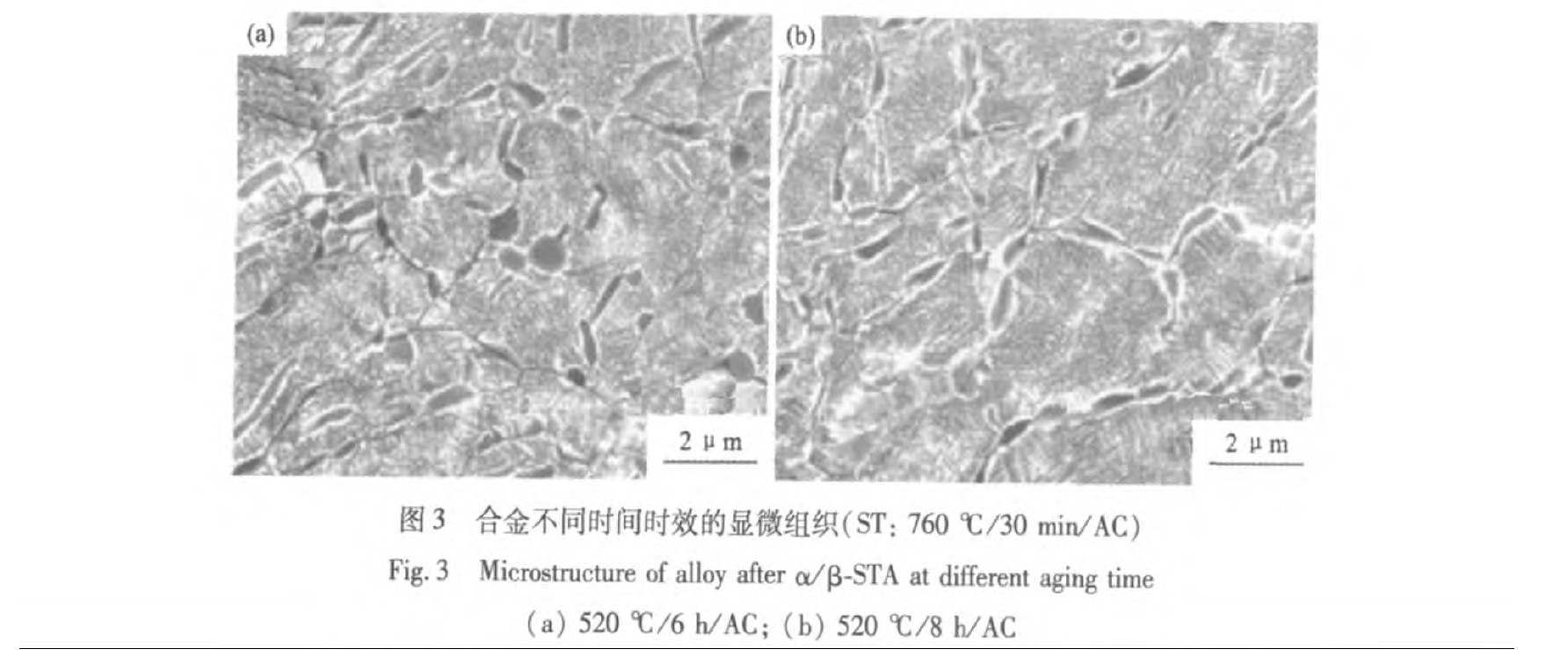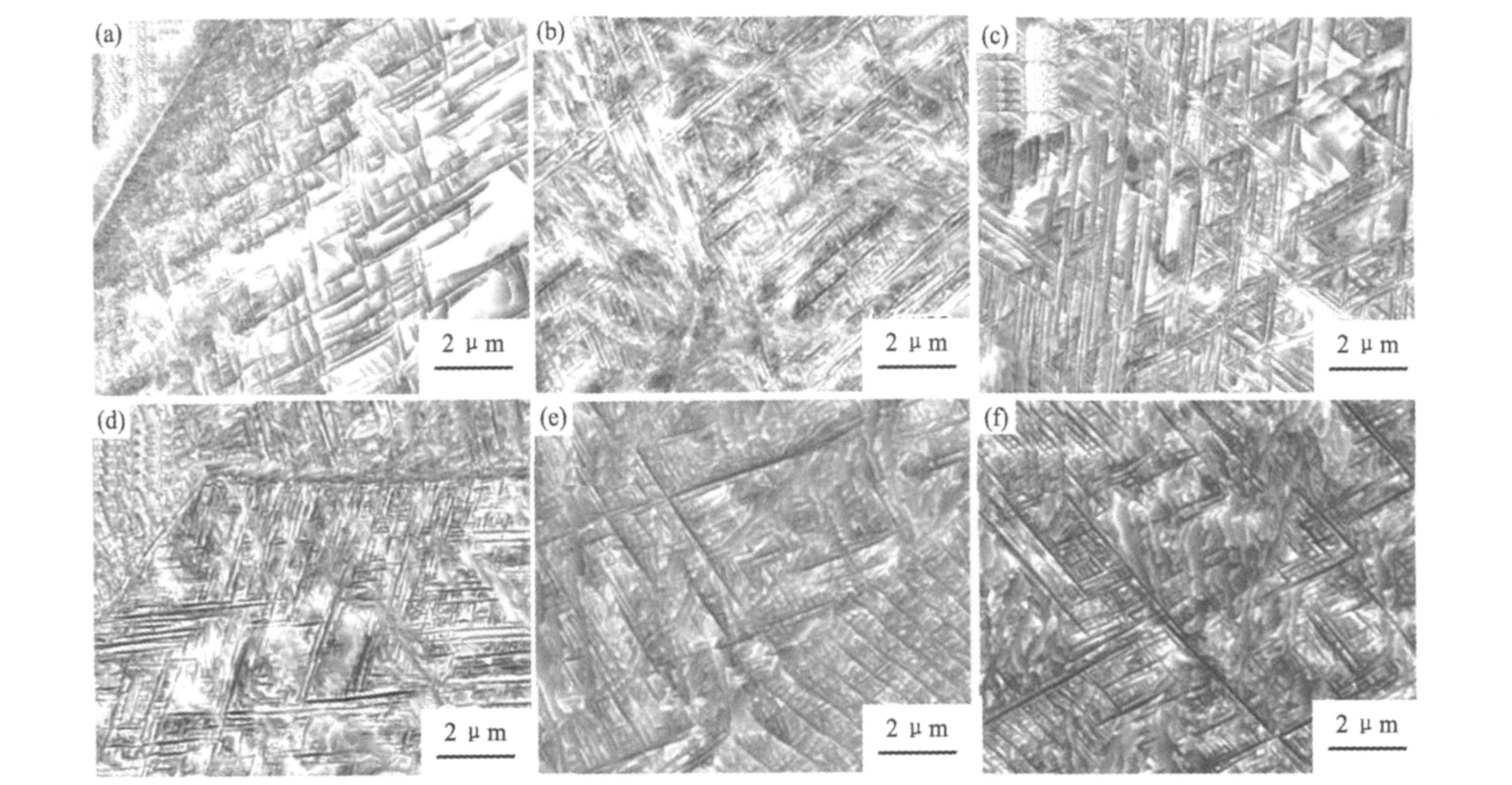时效对Ti-6Cr-5Mo-5V-4Al合金组织与拉伸性能的影响
北京有色金属研究总院有色金属材料制备加工国家重点实验室
宝钛集团有限公司
摘 要:
研究了时效对一种新型Ti-6Cr-5Mo-5V-4Al合金组织与拉伸性能的影响。研究发现:Ti-6Cr-5Mo-5V-4Al合金在α/β固溶+时效处理后的典型组织为:β晶粒破碎,β晶界处有连续和不连续的项链状初生α相,晶内有不连续的球状初生α相及时效过程析出纵横交错的细小次生α相。β固溶+时效处理后的典型组织为:等轴β晶粒晶界处析出沿着一定取向的次生α相薄片层,晶内弥散分布着平行交错的细小次生α相;在本研究范围内,Ti-6Cr-5Mo-5V-4Al合金经β固溶+时效处理时,低于500℃长时间时效和高于500℃短时间时效有利于合金强化;α/β固溶+时效处理时,低于500℃短时间时效有利于合金强化,而高于500℃或长时间都会降低合金强度,而且在较宽的时效温度范围内都具有良好的强度塑性匹配。Ti-6Cr-5Mo-5V-4Al合金在低于500℃时效时,α/β固溶+时效处理的合金其强度塑性匹配优于β固溶+时效处理处理后的合金;高于500℃时效时,β固溶+时效处理后合金其强度塑性匹配优于α/β固溶+时效处理后的合金。另外,短时间直接时效可以迅速提高合金强度,同时保持优良的塑性,500℃/2h直接时效后强度达1590MPa,同时保持6.5%的延伸率。
关键词:
中图分类号: TG156.92
作者简介:李成林(1985-),男,湖北人,硕士研究生;研究方向:钛合金;惠松骁,E-mail:huisx@grinm.com;
收稿日期:2010-03-04
基金:国家科技支持计划(2008BAE60B03)资助;
Effect of Aging on Microstructure and Tensile Properties of Ti-6Cr-5Mo-5V-4Al Alloy
Abstract:
Effect of aging on microstructure and tensile properties of a new type Ti-6Cr-5Mo-5V-4Al Alloy was studied.The experimental results showed that the typical microstructure of Ti-6Cr-5Mo-5V-4Al alloy with α/β solution and aging treatment was broken β grains,continuous and discontinuous necklace-like primary α phase at the β grain boundary,discontinuous spherical primary α phase in the intragranular,and small crossing secondary α phase precipitated during the aging treatment.And the typical microstructure of Ti-6Cr-5Mo-5V-4Al alloy with β solution and aging treatment was equiaxed β grain and secondary α phase precipitated at the equiaxed β grain boundary with a certain orientation,and small crossing secondary α phase homogeneous distributed in the intragranular.Ti-6Cr-5Mo-5V-4Al alloy dissolved in the β area and aging treatment,would be helpful to reinforce alloys when aging at temperature higher than 500 ℃ for a long time,or aging at lower than 500 ℃ for a short time.When dissolved in the α/β area and aging treatment,it would be useful to reinforce alloy aged at temperature lower than 500 ℃ for a short time;aging at temperature higher than 500 ℃ or for a long time would reduce the strength of the alloy,and also,there was is a good strength and plastic match for the alloy in a quite wide range of aging temperature.Ti-6Cr-5Mo-5V-4Al alloy,when aged at temperature lower than 500 ℃,the strength and plastic matched with α/β solution and aging was much better than that with β solution and aging,and when aged at temperature higher than 500 ℃,the results might be inverse.In addition,the short time direct aging treatment could rapidly increase the strength of the alloys,meanwhile,maintaining excellent ductility,such as the alloy directly aged at 500 ℃/ 2h,strength reached to 1590 MPa,while the elongation maintained 6.5%.
Keyword:
metastable β titanium alloy;aging;microstructure;tensile properties;
Received: 2010-03-04
钛及钛合金的密度小、 比强度、 比刚度高, 抗腐蚀性能、 高温力学性能、 抗疲劳和蠕变性能都很好, 具有优良的综合性能,是一种新型的、 很有发展潜力和应用前景的结构材料。 近年来, 世界钛工业和钛材加工技术得到了飞速发展, 海绵钛、 变形钛合金和钛合金加工材的生产和消费都达到了很高的水平,在航空航天领域、 舰艇及兵器等军品制造中的应用日益广泛,在汽车、 化学和能源等行业也有着巨大的应用潜力
Ti-6Cr-5Mo-5V-4Al合金是中国宝钛集团最新研发的一种亚稳定β钛合金, 该合金的设计按照多元强化及铝当量与钼当量匹配的原则。 根据文献
1 实 验
1.1 材 料
实验材料为真空自耗电弧二次熔炼的Ti-6Cr-5Mo-5V-4Al合金铸锭, 经开坯、 锻造、 轧制得到Φ12 mm~16 mm棒材。 用淬火金相法测得该合金的β相转变温度为780~790 ℃。 该合金化学成分如表1所示。
表1 Ti-6Cr-5Mo-5V-4Al合金化学成分
Table 1 Chemical composition of the alloy in mass fraction
Element |
Cr | Mo | V | Al | Fe | Si | C | Ti |
w/% |
5.700 | 4.700 | 4.810 | 3.930 | 0.080 | 0.028 | 0.025 | Bal. |
1.2 方 法
从轧制棒材上切取拉伸、 金相试样, 并分别在α/β区和β区进行不同温度的固溶处理后, 再分别经不同温度不同时间进行时效处理。 然后进行显微组织观察及室温拉伸性能检测。 拉伸试样采用Ф5 mm的标准拉伸试样。 拉伸性能测试按照GB/T228-2002金属室温拉伸试验方法进行。 金相腐蚀剂采用: HF∶HNO3∶H2O=1∶3∶7配比溶液。 SEM分析在FEI QUANTA 400仪器上进行。
2 结果与讨论
2.1时效温度对Ti-6Cr-5Mo-5V-4Al合金组织与性能的影响
将Ti-6Cr-5Mo-5V-4Al合金试样分别在760, 800 ℃保温0.5 h, 空冷后分别经460, 480, 500, 520 ℃时效处理2~8 h, 空冷。
图1是该合金在760 ℃/30 min/AC固溶后经不同温度时效8 h后的显微组织。 从图中可见, 晶界处有连续和不连续的项链状初生α相(图1(b), (c))
图1 合金α/β固溶后不同时效温度的显微组织(ST:760 ℃/30 min/AC)
Fig.1 Microstructure of alloy after α/β-STA at different aging temperatures
(a) 460 ℃/8 h/AC; (b) 480 ℃/8 h/AC; (c) 500 ℃/8 h/AC; (d) 520 ℃/8 h/AC
表2合金不同时效温度的拉伸性能数据(ST: 760 ℃/30 min/AC)
Table 2Tensile properties of alloy at different aging temperatures
Aging condition |
Rm/MPa | Rp0.2/MPa | A/% | Z/% |
460 ℃/8 h/AC |
1490 | 1413 | 7.5 | 26.5 |
480 ℃/8 h/AC |
1450 | 1380 | 8.0 | 29.0 |
500 ℃/8 h/AC |
1447 | 1413 | 10.5 | 41.0 |
520 ℃/8 h/AC |
1350 | 1317 | 13.5 | 45.0 |
表2是该合金在760 ℃/30 min/AC固溶后经不同温度时效8 h后的性能。 由表可见, 760 ℃/30 min/AC固溶时效后, 随着时效温度的提高, 合金强度从1500 MPa降低到1350 MPa左右, 而延伸率从7.5%提高到13.5%。 因此, 该合金在760 ℃/30 min/AC固溶后, 在较宽的时效温度范围内具有良好的强度塑性匹配。
图2是该合金在800 ℃/30 min/AC固溶后经不同温度时效6 h后的显微组织。 由图2可见, α相主要在晶界处沿一定位向析出, 而在晶内析出较少, 尺寸大且不均匀。 时效温度从460 ℃升至520 ℃过程中, α相尺寸从2 μm左右长大至4~8 μm, 从分布不均匀到均匀弥散分布, 而在500 ℃时效6 h时, α相尺寸小且分布均匀。 而由表3可知, 时效温度从460 ℃升至480 ℃时, 合金强度增加50 MPa左右; 从480 ℃升至500 ℃时, 强度增加140 MPa左右; 从500 ℃升至520 ℃时, 强度仅增加10 MPa左右。 在460~480 ℃时效时, α相相变驱动力大, 但温度低, α相析出受到原子扩散速率的限制, 析出较慢且不均匀; 500~520 ℃时效时, 原子的扩散速率较快, 但相变驱动力小, 同样也限制了α相晶核的析出速率; 而在480~500 ℃时效时, 相变驱动力和原子扩散速率刚好达到良好匹配, 所以此时α相的析出速率快, 合金强度迅速提高
2.2时效时间对Ti-6Cr-5Mo-5V-4Al合金组织与性能的影响
图3是该合金在760 ℃/30 min/AC固溶后分别经520 ℃时效6和8 h后的显微组织。 通过760 ℃/30 min/AC固溶后, 经520 ℃时效6~8 h时, 晶内的次生α相尺寸增大, 但是次生α相取向分布复杂, 交错程度变大。


表3合金不同时效温度的拉伸性能数据(ST: 800 ℃/30 min/AC)
Table 3Tensile properties of alloy at different aging temperatures
Aging condition |
Rm/MPa | Rp0.2/MPa | A/% | Z/% |
460 ℃/6 h/AC |
1210 | 1085 | 10.5 | 29.0 |
480 ℃/6 h/AC |
1263 | 1143 | 9.0 | 28.0 |
500 ℃/6 h/AC |
1400 | 1303 | 7.5 | 24.5 |
520 ℃/6 h/AC |
1413 | 1350 | 8.0 | 26.0 |
表4合金不同时间时效的拉伸性能数据(ST: 760 ℃/30 min/AC)
Table 4 Tensile properties of alloy at different aging time
Aging condition |
Rm/MPa | Rp0.2/MPa | A/% | Z/% |
520 ℃/2 h/AC |
1400 | 1360 | 12.5 | 44 |
520 ℃/4 h/AC |
1380 | 1343 | 12.2 | 47 |
520 ℃/6 h/AC |
1367 | 1337 | 13.0 | 49 |
520 ℃/8 h/AC |
1350 | 1317 | 13.3 | 50 |
表4是该合金在760 ℃/30 min/AC固溶后经520 ℃不同时间时效后的典型性能。 在研究的时间范围内, 延长时效时间, 合金强度略微减小, 塑性轻微增大, 因为时效时间延长, 产生过时效而次生α相轻微长大导致强度的减小
图4是该合金经800 ℃/30 min/AC固溶后, 经480, 500, 520 ℃, 6和8 h时效后的显微组织。 显微组织具有β固溶+时效后的典型特点
表5是该合金经800 ℃/30 min/AC固溶后, 经480, 500, 520 ℃, 6和8 h时效后的典型性能。 480 ℃时效时, 延长时效时间, 合金强度上升, 塑性下降; 500 ℃时效时, 强度和塑性无明显变化; 520 ℃时效时, 延长时效时间, 合金强度下降, 塑性上升。 在480 ℃时效时, 由于扩散速率低, α相需要更长的时效时间来完成形核和长大; 在520 ℃时效时, 由于扩散速率快, α相可以在较短的时间内完成形核, 而继续延长时效时间, 产生过时效, 此时会使α相长大甚至团聚而使合金的强度下降
图4 合金不同时间时效后的显微组织(ST: 800 ℃/30 min/AC)
Fig.4 Microstructure of alloy after β-STA at different aging time
(a) 480 ℃/6 h/AC; (b) 480 ℃/8 h/AC; (c) 500 ℃/6 h/AC; (d) 500 ℃/8 h/AC; (e) 520 ℃/6 h/AC; (f) 520 ℃/8 h/AC
图5 合金直接时效的显微组织
Fig.5 Microstructure of alloy after direct aging
(a) As-received; (b) Direct aging 500 ℃/2 h; (c) Direct aging 500 ℃/6 h
表5合金不同时间时效的拉伸性能数据(ST: 800 ℃/30 min/AC)
Table 5 Tensile properties of alloy at different aging time
Aging condition |
Rm/MPa | Rp0.2/MPa | A/% | Z/% |
480 ℃/6 h/AC |
1263 | 1143 | 9.0 | 28.0 |
480 ℃/8 h/AC |
1437 | 1360 | 7.5 | 23.5 |
500 ℃/6 h/AC |
1400 | 1303 | 7.5 | 24.5 |
500 ℃/8 h/AC |
1403 | 1340 | 8.0 | 28.0 |
520 ℃/6 h/AC |
1413 | 1350 | 8.0 | 26.0 |
520 ℃/8 h/AC |
1377 | 1307 | 9.0 | 27.0 |
2.3直接时效对Ti-6Cr-5Mo-5V-4Al合金组织与性能的影响
图5是该合金热轧棒材和500 ℃直接时效后的显微组织, 轧态原始组织中(图5(a))晶粒已被充分破碎, 晶界曲折而不连续。 经直接时效后, 晶内析出弥散分布的α相, 尺寸细小, 在1~2 μm左右(图5(b), (c))。 采用500 ℃直接时效2 h时, 强度接近1600 MPa, 而此时拉伸塑性仍然可达6.5%, 但时效时间过长会降低合金强度和塑性(表6)。 直接时效时, α相优先在轧制过程中的缺陷(如位错)等高能位置处形核析出, 所以短时间的时效过程便可使α相迅速析出, 使合金强度迅速提高
表6 合金直接时效后的拉伸性能数据
Table 6Tensile properties of alloy direct aged at different time
Aging condition |
Rm/MPa | Rp0.2/MPa | A/% | Z/% |
500 ℃/2 h/AC |
1590 | 1547 | 6.5 | 22.5 |
500 ℃/4 h/AC |
1577 | 1543 | 7.5 | 26.5 |
500 ℃/6 h/AC |
1580 | 1550 | 7.0 | 25.0 |
500 ℃/8 h/AC |
1570 | 1540 | 7.0 | 24.5 |
3 结 论
1. Ti-6Cr-5Mo-5V-4Al合金在α/β固溶+时效处理后的典型组织为: β晶粒破碎, β晶界处有连续和不连续的项链状初生α相, 晶内有不连续的球状初生α相及时效过程析出纵横交错的细小次生α相。 β固溶+时效处理后的典型组织为: 等轴β晶粒晶界处析出沿着一定取向的次生α相薄片层, 晶内弥散分布着平行交错的细小次生α相。
2. 在本研究范围内, Ti-6Cr-5Mo-5V-4Al合金经β固溶+时效处理时, 低于500 ℃长时间时效和高于500 ℃短时间时效有利于合金强化; α/β固溶+时效处理时, 低于500 ℃短时间时效有利于合金强化, 而高于500 ℃或长时间都会降低合金强度。
3. 在本研究范围内, Ti-6Cr-5Mo-5V-4Al合金在低于500 ℃时效时, α/β固溶+时效处理的合金其强度塑性优于β固溶+时效处理; 高于500 ℃时效时, β固溶+时效处理后合金其强度塑性优于α/β固溶+时效处理的合金。
4. 合金经500 ℃/2 h短时间直接时效后强度达1590 MPa, 同时保持6.5%的延伸率。
参考文献
[8] Leyens C,Peters M.Titanium and Titanium Alloys[M].Bei-jing:Chemical Industry Press,2005.





